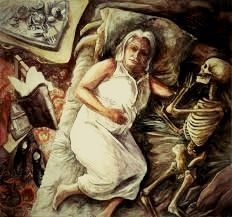Postcolonialism Interpretation of “I Started Early-Took My Dog"
Society Struggles Influence Emily
By Cynthea Eppley
Postcolonialism is a form of literary critique in which we analyze literature from the perspective of cultures oppressed, mainly by European colonization. Postcolonialism overlaps with other forms of literary criticism. These include but are not limited to Feminist theory, Queer theory, and African American theory. Not only does postcolonialism deal with different the ways forms of literary theory are affected by European colonization, but it also deals with different effects of colonization such as colonist superiority, othering, subalterns, dominant culture, mimicry, and anti-colonialist resistance (Tyson 262-269). Emily Dickinson’s poem "I Started Early-Took My Dog" has many postcolonialism features. Taking into account that the poem was written during the early years of the American Civil War, we can see how the fight for freedom, and against oppression, bleed through into Dickinsons' work despite her being removed from the battles.
One strong example of a postcolonial power struggle in the
poem is in the first few lines. These lines demonstrate clear dominant and
subalternate classes present in lines three through seven.
“The Mermaids in the Basement
Came out to look at me—
And Frigates—in the Upper Floor
Extended Hempen Hands—
Presuming Me to be a Mouse" (Tyson
326).
Through a postcolonialism lens, the mermaids and frigates would be an example of the dominant culture or colonizers in this situation. They specifically come out to look at the speaker and extend their hands, in an almost taunting fashion. This gesture can be seen as patronizing and assuming that the speaker is weak or lower class. Through this assumption is how through the use of the phrase “presumed to be a mouse.” This presumption of the speaker being a small, weak, animal puts them on a lower rung in the hierarchy. This dominant culture oppressing the subaltern continues throughout the poem.
Though there are themes solely about the colonizer vs the oppressed, there are themes of anticolonist
resistance. Anticolonist resistance is rebellion against the oppressors in
physical, psychological, and armed manners. The strongest example of this is in
lines 9-13.
“But no Man moved Me—till
the Tide
Went past my simple Shoe—
And past my Bodice—too—
And made as He would eat me up— ”
The action of the tide going up and taking over the speaker’s
body in a way can be interpreted as them accepting rebellion against the oppressive dynamic put
upon them by the dominant “colonist” of the mermaids and frigates. The speaker
being "eaten up" by the tide would be a psychological form their resistance. The ocean itself is often used as a symbol in literature. Dickinson herself used the ocean to carry deeper meanings. Over the years of her writing, the sea has symbolized
divine protection, mortality, the limits of human consciousness, and its power
to unsettle human understanding (Yothers). Knowing this, the sea
and tide taking over the speaker fit as a form of anticolonist psychological rebellion.
 |
"The Sea" by A Lehmann is licensed with the Emily Dickinson Museum |
One final postcolonialism critique present in “I Started
Early- Took My Dong” is mimicry. This can be seen when the speaker goes back to
the town and the tide bows back from them.
“Until We
met the Solid Town—
No One He seemed to know—
And bowing—with a Mighty look—
At me—The Sea withdrew— ”
Through the use of the speaker and the sea meeting in town
and then leaving we can interpret that the speaker wanted to continue their rebellion,
but in the end went back to mimicking the culture of the colonizer or dominant
culture. This can be exemplified in line 22 “No One He seemed to know.” With no
one else sharing in the speaker’s rebellion, they then know they must go back
to the dominant culture. The sea withdrawal would then be the speaker's previously mentioned psychological rebellion leaving them. This would then solidify the speaker mimicking the dominant culture to survive.
 |
| "Frazar Stearns" Licensed by Amherst College Collections |
Emily Dickinson's poem "I Started Early-Took My Dog" is a good example of postcolonialism criticism. It shows oppressors, the oppressed, a chance to rebel, and having to mimic the dominant culture to survive. Since the poem was written against the backdrop of the early years American Civil War we can see how societal struggles for freedom permeate Dickinson's work despite her physical detachment from the battlefield. This permeation can only be seen through the features of postcolonial criticism.
Work Cited
Emily Dickinson Museum. "Emily Dickinson and the Civil
War." Emily Dickinson Museum,
www.emilydickinsonmuseum.org/emily-dickinson/biography/special-topics/emily
dickinson-and-the-civil-war/.
Accessed 7 Mar. 2024.
Marvelly, P. (2016, May 13). Emily Dickinson: A Woman Before
Her Time. The Culturium.
Retrieved March 10, 2024, from https://www.theculturium.com/emily-dickinson-a-woman-before-her-time/
Tyson, Lois. “Using concepts from postcolonial theory to
understand literature” Using Critical
Theory,
Routledge, 2021,
Yothers, Brian. "Going to Sea in Emily Dickinson’s
Poetry: Decentered Humanism and Poetic
Ecology." Dickinson Electronic
Archive, www.emilydickinson.org/emily-dickinson-lyrical-ecologies-forays-into-the-field/going-to-sea-in-emily-dickinson-s-poetry-decentered-humanism-and-poetic-ecology.
Accessed 6 Mar. 2024.



I'm not sure if you have a thesis or not, but I feel like you are talking about how ISETMD embodies all aspects of the post colonial theory.
ReplyDeleteThe quotes from the text are good to explain post colonial theory.
I noticed one thing where you would include the parenthesis in the quote (tyson)." just be sure to do words" (tyson).
I also like the history behind Emily Dickinson